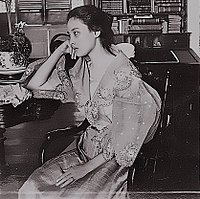This article needs additional citations for verification. (January 2025) |

The clothing style and fashion sense of the Philippines in the modern-day era have been influenced by the indigenous peoples, Chinese waves of immigration, the Spaniards, and the Americans, as evidenced by the chronology of events that occurred in Philippine history. At present, Filipinos conform their way of dressing based on classic fashion or prevailing fashion trends.
Apart from Western influence, the Philippine style of clothing was dictated by its climate. With a tropical climate (dry and rainy seasons), indigenous groups wore and to this day still wear colorful woven clothes, often with intricate beadwork and other ornam a type of a collarless shirt – which later became adorned with laces, trimmings, buttons, and a collar – was where from the barong tagalog evolved. On the other hand, the Bahag was a type of loincloth or G-string worn by certain indigenous groups.
Some Filipinos wear T-shirts together with denim jeans (locally referred to as maong) trousers for men and skirts for women. The "jeans and T-shirts" combination was introduced to the Filipinos by the Americans.[according to whom?]
Some also wear Madras type of shorts called puruntongs (singular: puruntong, a type of pair of shorts or Capri pants) combined with sleeveless shirts or T-shirts. During the rainy season and cold evenings in December and January, some Filipinos wear hooded jackets.
